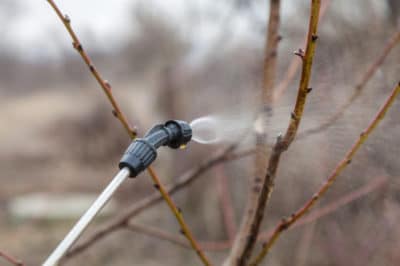Spraying Dormant Oils on Peach Trees
Peach tree borer, scales, and other common pests of peach trees can be controlled by applying a dormant oil on the tree in winter.
Spray the tree before it shows new, green growth in spring but when temperatures are above 40ºF (4.4ºC).
Always read the dormant oil package instructions carefully before mixing or using the product, and be sure you have the necessary spraying equipment and protective clothing for doing this job.
To apply dormant oil:
- Only spray when temperatures are expected to stay above approximately 40ºF (4.4ºC) for a week or longer after you spray.
- Shake and mix the oil completely before using it.
- Spray the entire surface of the tree and its branches.
- Follow all product package directions and quantities carefully for the specific type and size of fruit tree you are spraying.
Spraying for Peach Leaf Curl
Peach leaf curl is a common fungus disease affecting peach and nectarine trees. Red and puckering leaves in summer is an easy to spot symptom, but by this time, it is too late to take action until the following winter. Then, treatment with a copper-based fungicide spray can often get the problem under control for the next growing year.
Spray copper and sulfur fungicides when the leaves have fallen in the fall. An additional spraying can be done in the spring just as the buds start to swell but before green tips appear on the twigs and branches.
Cover the tree and all branches completely with the spray. During wet weather it may be necessary to spray more than once in a season. Always apply these sprays well before or after bloom time because they can interfere with the activity of bees and other pollinators needed for good fruit set.
